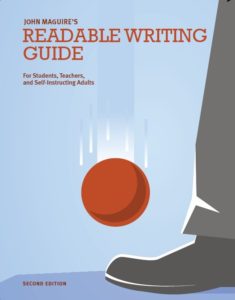Teachers rarely question the idea that writing is thinking. You know the cliche: Writing is thinking on paper.

But they should. Writing is thinking on paper, yes, but that’s not the best way to teach it. Far better is to teach good writing habits as behaviors that can be practiced and made second nature. When we do this, we can benefit from the latest research on effective behavior change. Athletic coaches use that research. Why shouldn’t we?
Animal trainer Karen Pryor, now in her 80s, published a brilliant break-through book on training nearly 40 years ago. It’s called Don’t Shoot the Dog! She writes that you can train any animal—fish or fowl, dog or human—to do almost anything physically possible. You just communicate what behavior you want and deliver rewards. You go step by step, rewarding and reinforcing progress at each stage, until you get the final result. Behavior coaches like Pryor, in other words, (1) identify the final behavior wanted, and (2) figure a series of steps that will get there.
Dear instructors, why is college writing not taught that way? You probably know the answers.
First, the academic bigwigs cannot agree on what behavior they want. They won’t define “good writing.” They pretend that all styles are equal, that a personal voice is all that matters and that squashing a student’s personal voice is unthinkable. Thus, they can’t announce If the animal can do X consistently, it has learned the skill. They can’t or won’t establish a target.
Second, without a defined target skill to aim for, academics cannot break instruction down into steps, either. (Yes, they do talk about “steps” of the writing process, but without a final behavior goal such steps are aimless.)
I submit that we need a behavioral training method.It should include:
1. The assumption that writing is a behavioral performance, like swinging a tennis racket or diving or improvising jazz piano
2. An objective definition of the good performance
3. A breakdown of the performance into parts
4. An identifiable sequence of actions that will train the skill
—
There is a new method like that, as readers of this blog know. It’s called the Readable Writing Method.
It assumes writing is a performance, not unlike playing tennis. It uses an objective definition of the good performance—prose that scores well on the Flesch readability scale. (An explanation follows) Since the factors that produce a good Flesch score are known, students can be trained in them. Under expert eyes, students can move from easy behaviors to harder ones, always with the aim of readable writing in mind.
The linguistic researcher Rudolf Flesch worked at Columbia University in the 1940s and 1950s. He became a best selling author with his books on writing. Flesch fully proved that we what consider readable writing is determined by the intersection of three linguistic variables–average sentence length, average syllable length, and percentage of what he called “human interest words.”
Although there’s a range of readable styles, it’s fairly narrow. No one calls prose “readable” that has an average sentence length of 90 words per sentence. We can train students to write in the band of readable styles and produce papers that that score well, and we do. (For sentence length, our students aim for an average 15-17 words per sentence.)
In Readable Writing Method, students learn to write clear, active and interesting sentences at will. We make them identify and edit their fuzzy and boring sentences themselves.
Then in the second part of the course, we train students to create organized essays from those interesting sentences. The performance standard: the reader must never get lost.
Will training to hit certain numerical targets result in soulless, mechanical writing? Not at all. Learning the rules of readability is like learning the rules of baseball. Learning the rules of baseball doesn’t produce mechanical or soulless ball players, does it? Training college freshmen in being readable—putting that in front of them as a goal—can only benefit them. The student who understands readable writing is empowered to be eloquent.
Though it’s just beginning to spread, the Readable Writing Method of behavioral training does exist. Within it, students are reading differently, writing differently and seeing the categories of language differently.
It can be hard to trust a new method. Like the first man who jumped from an airplane with a parachute, you’ll find it hard to believe that Readable Writing activities will be sufficient to support the student. You’ll fear focusing on readable sentences and essays will take student attention away from thinking. You’ll discover, though, that putting student attention on the exact words and sentences they are using actually glues their attention to the quality of their thinking. Closer attention to words—the essence of this course–means closer attention to thinking.
If you took all your first-year writing syllabi to the backyard, put them into a pile and burned them, how would you start back up? Would you try to remember your most recent course outline? Or would you create something new? If something new, think behavior and write this at the top of your page:
What do I want students to be able to DO on their own at the end of 14 weeks? How can I get them there?
##



Leave a Reply